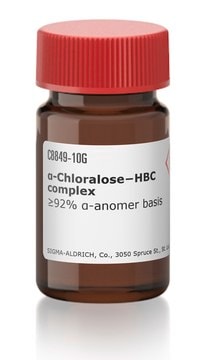23120
α-Chloralose
≥98.0% (chloralose, AT)
Synonym(s):
1,2-O-(2,2,2-Trichloroethylidene)-α-D-glucofuranose, Anhydro-D-glucochloral, Chloralose
About This Item
Recommended Products
Assay
≥98.0% (chloralose, AT)
form
powder
optical activity
[α]20/D +17±2°, 5 hr, c = 2% in ethanol
impurities
15% Beta-chloralose
mp
178-184 °C
solubility
water: soluble 1 gm in 225 ml at 15 °C
chloroform: slightly soluble
diethyl ether: soluble
glacial acetic acid: soluble
petroleum ether: insoluble
SMILES string
OC[C@@H](O)[C@H]1O[C@@H]2O[C@@H](O[C@@H]2[C@H]1O)C(Cl)(Cl)Cl
InChI
1S/C8H11Cl3O6/c9-8(10,11)7-16-5-3(14)4(2(13)1-12)15-6(5)17-7/h2-7,12-14H,1H2/t2-,3+,4-,5-,6-,7-/m1/s1
InChI key
OJYGBLRPYBAHRT-IPQSZEQASA-N
Looking for similar products? Visit Product Comparison Guide
Biochem/physiol Actions
Components
Other Notes
Signal Word
Danger
Hazard Statements
Precautionary Statements
Hazard Classifications
Acute Tox. 3 Oral - Acute Tox. 4 Inhalation - Aquatic Acute 1 - Aquatic Chronic 1 - STOT SE 3
Target Organs
Central nervous system
Storage Class Code
6.1D - Non-combustible acute toxic Cat.3 / toxic hazardous materials or hazardous materials causing chronic effects
WGK
WGK 1
Flash Point(F)
Not applicable
Flash Point(C)
Not applicable
Personal Protective Equipment
Certificates of Analysis (COA)
Search for Certificates of Analysis (COA) by entering the products Lot/Batch Number. Lot and Batch Numbers can be found on a product’s label following the words ‘Lot’ or ‘Batch’.
Already Own This Product?
Find documentation for the products that you have recently purchased in the Document Library.
Our team of scientists has experience in all areas of research including Life Science, Material Science, Chemical Synthesis, Chromatography, Analytical and many others.
Contact Technical Service









